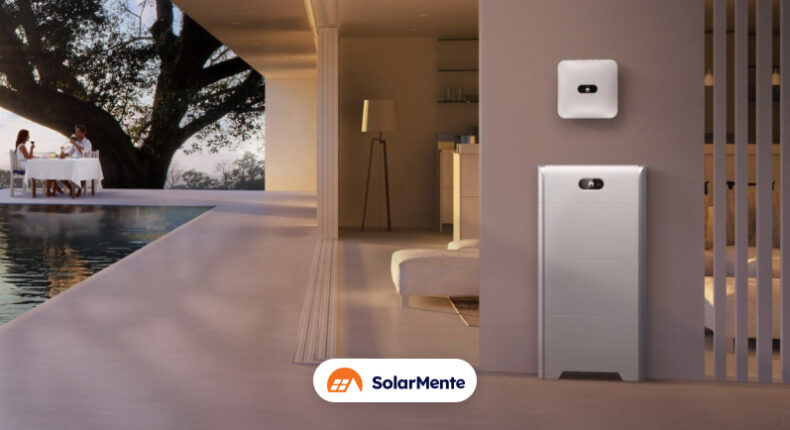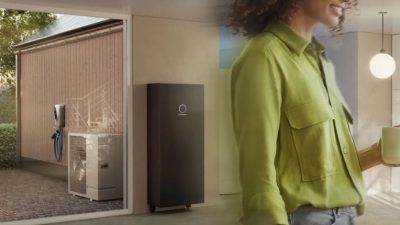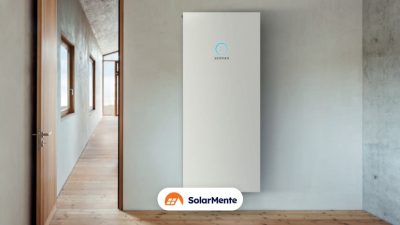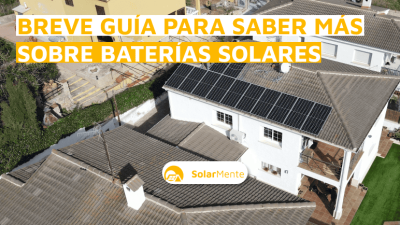Installing batteries for your solar panels means savings of up to 80-90 %.
When the modules are not generating power at night, these devices provide us with electricity. This is why your electricity costs are significantly reduced.
Selling the surplus to your electricity company will not result in any significant financial compensation.
If you want to get the maximum output from your installation, a solar battery is key.
But with so many manufacturers on the market, the choice is not easy.
To help you in your search for the right device, we have prepared a guide that analyses the most important characteristics and a selection of the best batteries for solar panels on the market.
The 5 best batteries for solar panels: analysis of each model
If you want to know if a battery delivers the results it promises, you have to test it first.
And that’s exactly what our team of solar experts has done.
An analysis of the models on the market in order to compile a list of the best solar batteries on the market today.
Here are the winning models that we currently use with our customers:
Huawei
Sonnen
Sungrow
Enphase
Huawei Luna 2000
The Huawei Luna batteries were warmly received in the market.
In particular, we will focus on the Luna 2000 model, the one we use in our photovoltaic installations.
And the first thing to note about the manufacturer is its modular design.
This means that you can expand the capacity of the system to adapt it to your energy needs. Therefore, we are talking about a versatile product.
What are the capacities to be installed?
We tell you:
Power 5 kWh. It is ideal for homes with standard consumption.
Power 10 kWh. It is the perfect solution for homes with high energy consumption.
Power 15 kWh. This model is used for large homes, communities of neighbours or businesses that require a high level of electricity to supply the spaces.
On the other hand, if you do not have enough space inside your home, it is not a problem to install it outside. In addition, it has the great advantage that it can be mounted in two ways: wall-mounted or free-standing.
This allows for greater flexibility in its installation, with no limitations in between.
It is also easy to install and waterproof.
Using the app, you can control the production of the system and make an efficient and intelligent consumption.
The following advantages are also worth mentioning:
Its discharge capacity is 100%.
It has a backup charge and discharge function.
It is suitable for both residential and commercial applications.
Its weight is reduced and, therefore, facilitates assembly and mobilisation.
This manufacturer is not compatible with other brands, therefore, it can be used only for other components that are also Huawei.
The best:
+ Easy installation
+ Good value for money
+ Residential and business use
+ Modular solution to increase capacity
Please note:
– Not compatible with other manufacturers
SonnenBatterie 10
We use two models of Sonnen batteries.
The first one we are going to analyse is the sonnenbatterie 10.
This model acts as an additional consumption in our home as it does not allow direct current. However, its intelligent system maximises the use of energy.
But the most remarkable and differential compared to other solar batteries is its compatibility with any inverter or existing self-consumption installation.
It is advisable to install it in places of passage or in the garage itself, for a simple reason:
Its forced ventilation.
The noise it generates is similar to that caused by a computer, that is to say, it is somewhat annoying.
That is why it is not advisable to place it in rooms where we spend most of our time, such as, for example, the living room.
Beyond that, it has a power of 4.6 kW, has a maximum efficiency of 96.8% and you can choose between the following capacities:
5.5 kWh .
11 kWh .
22 kWh.
It also has a 20-year service life, 10,000 guaranteed discharge cycles and a 10-year warranty on all components.
But of course, as long as the battery is used correctly and under optimum conditions.
In short, the SonnenBatterie 10 is perfect for new or pre-existing installations thanks to its compatibility with all other inverters.
The best:
+ Capacity up to 22 kWh
+ Compatible with any inverter from other manufacturers
+ Sustainable technology (they are free of cobalt and other heavy materials).
Please note:
– Heavier and larger than other batteries
– Slightly higher price
SonnenBatterie 10 performance
What is the difference compared to the previous model?
Its design is intended for three-phase installations.
Therefore, we are talking about a model with:
More power.
More capacity.
In fact, it allows modules with capacities of up to 55 kWh and a power of 9.9 kW.
The rest of the characteristics remain the same.
Opting for this model is convenient when your home has a large energy consumption. For example, if you have an aerothermal system.
Tesla Powerwall battery
The Tesla Powerwall battery is one of the most popular batteries on the market.
It consists of lithium ions and has the great advantage of adapting to any existing photovoltaic installation.
It is true that this model is not modular, but you can stack several batteries with a useful capacity of 13.5 kWh and a nominal power of 5 kW, the industry standard. The maximum number of batteries to be stored is 10.
As for the round-trip efficiency, it is 90%.
That is, you can use 90% of the stored energy and the remaining 10% will be lost in the storage process.
On the other hand, it has a depth of discharge (DoD) of 100%, i.e. it is able to charge up to 100% of its capacity.
The dimensions may come as a surprise, but its compact size and minimalist design offers different options for both indoors and outdoors, making it a welcome addition to the home décor.
Monitoring and optimisation
Tesla has an application to monitor your home’s energy production and consumption in real time.
Simply set your preferences to:
Protect yourself against power cuts.
Optimise your energy independence.
Save on your electricity bill.
What’s more, its application includes instant alerts and remote access to control the self-consumption installation from anywhere.
Beyond that, Tesla’s Powerwall battery has the following advantages:
It is safe for both children and pets, because it has no wires in sight and no hot outlets.
It is robust in the most extreme weather conditions.
It is waterproof and dustproof.
It comes with a 10-year warranty.
The best:
+ Compatible with new and existing solar modules
+ Large capacity (13.5 kWh)
+ Design suitable for indoor and outdoor use
+ Water and dust resistant
Please note:
– Not modular (only one size)
Sungrow batteries
Sungrow batteries have a differential feature compared to other brands in the sector: their compatibility with GridX.
It is a system that allows total monitoring of home consumption.
But it also stands out for its competitive price with a good quality-price ratio.
In addition, it is modular and can support from 3 to 8 modules per unit, taking into account a maximum of 4 units in parallel. This will allow you to expand the installation if your energy needs change.
In terms of capacity, you have the option of choosing from 6.4 to 25.6 kWh.
On the other hand, installation couldn’t be simpler. No cables are needed between the battery modules and it is compact and lightweight.
Like the other models tested, it has a 100% depth of discharge and a 10-year warranty.
And another highlight is its safety as it is made of lithium-ferrophosphate, and includes a protective design with several layers of measurement and extensive safety certification.
Highlights:
+ Easy installation
+ Large capacity (up to 25.6 kWh)
+ GridX compatibility
+ Good value for money
Please note:
– Only compatible with Sungrow inverters
Enphase batteries
If you’re already comparing solar batteries, you may be familiar with Enphase microinverters.
One of the great allies of homes affected by shading.
But that’s not all.
The manufacturer has decided to expand its range of products and move into accumulators with its Enphase 3T and 10T models.
These components are designed for single-phase and low-voltage installations with a storage capacity of between 3.5 kWh and 10.5 kWh.
However, these batteries only work with the manufacturer’s microinverters.
Despite this, their advantages are clear:
It has a decentralised system.
It is suitable for solar and gas generators.
It incorporates a back-up power function.
The differential value of Enphase batteries, as with microinverters, is that they optimise energy production. They maintain operation even if one of the microinverters fails.
Another highlight is that it has a round-trip efficiency of 89%.
What does this mean?
The higher the percentage, the more efficiently it can convert the incoming electricity into stored electricity and generate electricity suitable for consumption again.
Expandable
It also has a modular design so you can expand the installation as your energy needs change.
And when it comes to warranties, it outperforms its competitors and is set for 15 years.
We also like its application that includes a simple interface to monitor how much energy you have stored, the electricity you consume and whether you use energy from your solar panels or the grid to charge the battery, among others.
Finally, this type of installation is ideal for homes that are frequently shaded and can still produce energy without problems.
The best thing about it:
+ Modular
+ High one-way efficiency
+ Automatic detection of grid faults
+ It is compatible with solar and gas generators.
Please note:
– Only compatible with Enphase microinverters.
– Higher cost
Comparison of the best batteries for solar panels in 2023
Here is a comparison table with all the models analysed.
Note: if you view the table from your mobile phone, scroll with your finger to see it in full.
Model
Batterie sonnen 10
10 performance
Sungrow
Enphase
Huawei Luna 2000
Tesla Powerwall
Installation type
Single-phase
Three-phase
Single-phase, three-phase and solar farms
Single-phase
Single-phase and three-phase
Single-phase and three-phase
Total capacity
storage
5.5 – 22 kWh
11 – 55 kWh
6.4 – 25.6 kWh
3,5 – 10 kWh
5 – 15 kWh
13,5 kWh
Depth of discharge
100 %
100 %
100 %
100 %
100 %
100 %
Compatibility
Any other manufacturer
Any other manufacturer
Only compatible with Sungrow inverters
Only with Enphase microinverters
Huawei products
Any other manufacturer
Is it modular?
No
No
Yes
Yes
Yes
No
Warranties
10 years
10 years
10 years
15 years
10 years
10 years
Guide to choosing the best battery for solar panels
Whether you:
You are going to install solar panels on your roof.
You already have a PV system and want to save more.
It is important to consider a number of factors in order to choose the best battery for your PV system.
There are more and more models on the market and it is crucial to pay attention to what makes the difference.
Therefore, to get the maximum performance and savings from your installation, we have prepared this guide where we review everything you need to know to get the right model.
Types of solar batteries
There are 4 types of solar batteries on the market:
Open lead acid batteries.
AGM batteries.
Gel batteries.
Stationary batteries.
Lithium batteries.
Please note that the majority of accumulators for residential use are lithium batteries, although we can also find lead acid batteries. However, they are of lower quality and also cheaper.
If you want more information, in this article we tell you in detail about each type of solar battery.
Storage capacity
The storage capacity is one of the essential points when choosing the best solar panel battery for our home. It is measured in kilowatt-hours (kWh).
But what exactly is it?
Look.
This factor indicates how much energy a battery can store for later use.
The first step in choosing one capacity or another is to know the consumption of your home, therefore:
If the energy costs are not high, a 5 kWh battery is sufficient.
If the costs are high, we should consider capacities of around 10 or 20 kWh.
Although this is rare, you should also consider the capacity required in the event of a blackout.
Is the battery modular?
When we talk about modular batteries, this means that they can be customised to adapt to changes in a home’s energy consumption.
In other words, if your domestic consumption increases and you need a higher capacity, these models are flexible and allow for modular expansion.
But before you buy a battery, consider the following questions:
Can I extend the capacity with the same battery?
Do I need to buy a new one?
Do they have to be the same size?
How many modules can I stack?
Let’s look at this by example.
Imagine that, evaluating your needs, you are going to install an 11 kWh battery.
But after a while, you buy an electric car that requires a higher capacity and you decide to install a charging station. In this case, your energy needs are likely to change.
What would you do in this case?
Well.
If you buy a modular battery you can:
Expand the capacity with another battery of the same size.
Install a battery with different dimensions in the current installation.
Increase the capacity by small amounts (usually two or three kWh).
Nominal power
Measures the rate at which the battery can discharge or release stored energy.
However, there are two types of power ratings: peak and continuous.
Peak power is the amount of electricity a battery produces instantaneously. That is, batteries with high capacity but low power ratings are capable of powering small devices for a longer period of time.
On the other hand, batteries with lower capacity but high power ratings generate powerful bursts of energy in more limited periods of time.
Continuous power, on the other hand, refers to how long a battery is capable of powering the device. In most cases this figure stays within 5 kW.
For example, in larger houses with a higher energy requirement, a higher power output is recommended.
However, the power outputs vary depending on whether they are connected to the grid or not.
However, if you are planning to disconnect from the grid, you will probably need a larger number of batteries.
Depth of discharge
Depth of discharge (DoD) is the amount of energy available from the battery before recharging.
This is represented as a percentage and the closer it is to 100%, the better.
Simply because you will be able to use the battery for more hours during the day.
However, most manufacturers indicate their maximum and usable capacity:
Maximum capacity: The total amount of energy the battery can store.
Usable capacity: The total amount of energy to use.
For example.
If you buy a battery with a capacity of 11 kWh and a discharge of 90%, this means that you should not use more than 9.9 kWh before charging the battery again to avoid performance problems.
Round-trip efficiency
This factor mentions the amount stored in a solar battery that can be used as energy output.
The higher the percentage, the more round-trip efficiency it has and therefore the more capacity is used.
Compatibility
Check the compatibility of the solar battery with the other components of the system, especially if you already have an existing installation that limits you in the choice of one device or another.
Some models, such as Huawei, are only compatible with products from the same company. However, batteries such as Sonnen and Tesla have the advantage of being compatible with other manufacturers, which makes the choice easier.
Warranty and maintenance
Considering that the investment in solar batteries is high, it is normal to look for a comprehensive warranty from the manufacturer.
As a general rule, companies offer a 10-year warranty or calculate this after a certain number of cycles.
This figure gives a clue as to how long the battery will last.
Look at how much more performance it can guarantee for your installation and how long it will last.
How much do they cost?
The price of solar batteries differs depending on several factors that we have analysed, such as the type, capacity, power or depth of discharge, among others.
Lithium batteries, which are the most commonly used for homes, can start at around 5,000 euros and go up to over 10,000 euros, but it depends on the capacity and power. Their performance is higher and, therefore, the price is higher.
But if you want to know how much it can cost you, you can always turn to solar energy experts to help you in the process of selecting the best battery for your photovoltaic installation.
>> Calculate the budget for your solar batteries
Do you already know which solar battery to choose?
In this article we have compiled the best batteries for solar panels on the market according to our team of experts.
A good solar battery should provide you with maximum performance in your photovoltaic system, storing the maximum amount of energy for use when sunlight is not available.
No one model is better than another, but energy needs vary from one individual to another, so it is important to consider the features mentioned in this guide.
Are you sure which battery you need?
If you are still unsure, we can help you choose the right model for you.
Just click on this link and calculate your solar battery budget.
See you inside!
Frequently asked questions
Can I add a battery to an existing solar installation?
Yes, you can add batteries to your existing system. But remember, not all models are compatible with components from other manufacturers.
In any case, we advise you to contact your installer and decide the best solution for your case.
Can I qualify for subsidies for the installation of solar batteries?
As with panels, batteries are also eligible for grants and subsidies for their installation, such as the Next Generation Funds.
Do I need a solar battery to power my electric vehicle?
It is not necessary to install solar batteries to power your electric car charger. You can use your solar panels and make use of net metering to compensate for the cost of electricity consumed outside of peak energy production times.














